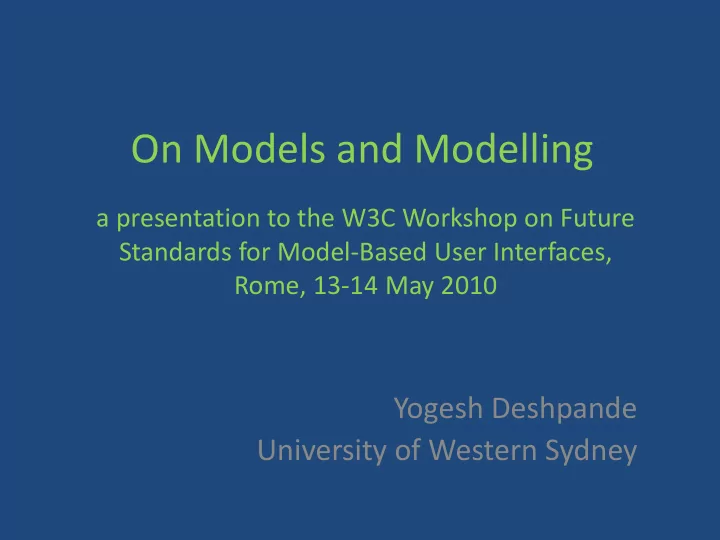

On Models and Modelling a presentation to the W3C Workshop on Future Standards for Model-Based User Interfaces, Rome, 13-14 May 2010 Yogesh Deshpande University of Western Sydney
user interfaces for everyone? vision simulation from Arizona Center for the Blind and Visually Impaired, Inc: http://www.acbvi.org/albums/vision
current interests (1) • large-scale information management in the AEC (Architecture, Engineering and Construction sector) – users: planners, architects, engineers, owners, facility managers, contractors, end-users (tenants, shoppers...) • full list not enumerated at this stage • will continue to evolve – problems of standard terminology across A, E and C and countries (ontologies?) – accessibility concerns add complexity – UIs and UI modelling are of direct concern – technologies (mobile and others) add another dimension
current interests (2) • Green ICT – similar concerns as with the AEC sector problem • users – lay persons to policy makers (un-enumerated and evolving) – internationalisation (languages and culture) probably of greater influence on UI than in the AEC sector • i need models (say it three times, with emphasis on each word)!
some background • what are models? an idiosyncratic answer: – attempts to nail down vague ideas to build a bigger picture that can be tested for validity • a few observations based on personal experience : – statistical modelling – mathematical modelling – OR modelling – simulation modelling – architectural • some models not worth commenting upon here: – economic and econometric – religious – science fiction (Dune, Foundation trilogy, Space Odyssey?)
characteristics of models • statistical modelling – empirical, data-based, rigorous basis in theory – developed as descriptive then used as predictive – design of experiments for rigorous modelling – both data-based and predictive/hypothesis testing models have been abused in practice, examples: MLR, ANOVA, … • OR modelling – mathematical, probabilistic, based on data and observations, use sensitivity analyses • simulation modelling – repetitions – conscious, theory-based attempts to remove bias (antithetical sampling)
to be realistic: models and modelling in these areas also have not had smooth sailing examples? • integer programming for everything! • new problems re-formulated in old models • multiple linear regression and hypothesis testing in inappropriate ways • simulation models based on insufficient validation
underlying characteristics of models • measurements • verification and validation objective • to build a bigger, realistic picture that can be tested for validity how do software models, including UI models. fare on these points?
verification? the proof of a programme is: • it executes successfully on the computer and • gives the expected answers to the (often artificial) test data
validation? the proof of UI is: • it works in the expected way if the user follows the instructions correctly • (we are not responsible if the user does something unexpected or an unforeseen event takes place)
users make mistakes unforeseen events happen ... can we model these?
a bit more on modelling • a brief anecdote of a 1993 survey – methodologies mainly used for documentation after the event – mainly e-r diagrams – pre-OO, pre-UML • teaching – students in mathematics, statistics, OR, Simulation (even economics) who understand the importance of models as the starting point; not so computing students – UML is still not well-understood; anecdotal evidence suggests that it’s more popular in academia than in industry – MVC is now more widely promoted but needs to be illustrated properly and exhaustively with appropriate models
from Jean- Loup’s presentation yesterday • for the end-user GUI is the application • an iceberg with V above the sea level, CM below it • similar to my students’ reaction to MVC
an insight? • agile/iterative • (VCM)(VCM)(VCM)... • = • (VC)(MVC)(MVC)(M... • is it time to reconsider MVC?
utility of standards • obvious in this forum • from the teaching perspective: – Web standards help students both to understand their purpose and to use them as checklists • XHTML, CSS are seen as simple whereas WAI and accessibility on the whole are treated as important to a class of users – questions • can we create guidelines for choosing appropriate models and modelling techniques? • how are the myriad models, available in literature, tested? (the expressions of interest for this Workshop list about 10 models or variations thereof) • how can the models be made rigorous? surveys? focus groups? questionnaires? click-streams?...
summary • modelling is difficult but essential • measurements are lacking • testing strategies take care of verification of the code but are they enough overall? • validation must become a primary concern – walkthroughs are not good enough, merely verbal validation! • standards will help in teaching • vision simulation is just one example of how complex UI modelling will be – this is more like a start
two (temporary) conclusions i need models we need standards
Recommend
More recommend